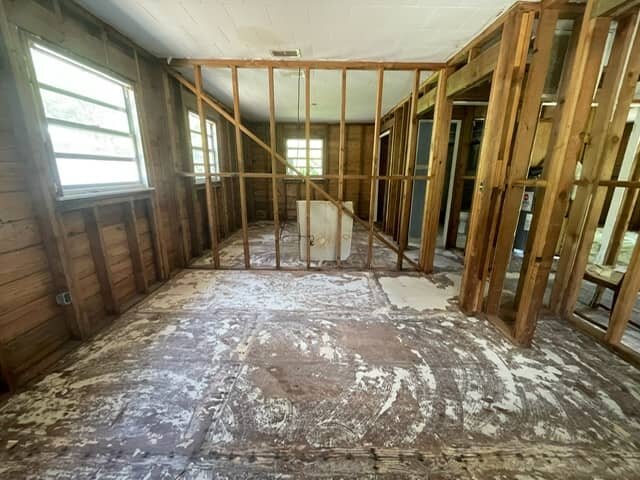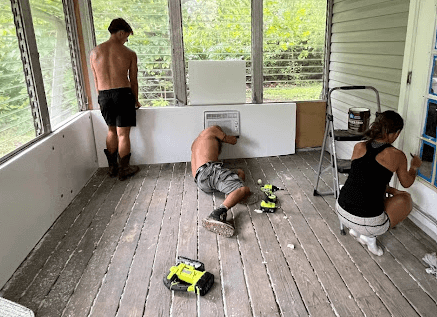What is a Furring Wall? A furring wall is an interior wall construction technique where strips of wood or metal, called furring strips, are attached to a wall to create an air space or to provide a level surface for the attachment of finish materials. Are you tired of uneven or unattractive walls in your home? Or are you looking to improve your property’s insulation and soundproofing? If so, furring walls might be the perfect solution for you. In this blog post, we’ll explore everything you need to know about what is a furring wall. Whether you’re a homeowner, a DIY enthusiast, or a real estate investor, this guide will provide better insights and practical advice to enhance your property.
Furring walls are essential in building construction, providing a smooth, level surface for finishing materials. According to real estate investors Steve Daria and Joleigh, understanding what is a furring wall and its advantages can significantly enhance a property’s structural integrity and aesthetic appeal. Incorporating furring walls into your projects can improve insulation and noise reduction, making them a valuable addition to any construction plan.
What is a Furring Wall?
What is a furring wall, exactly? a furring wall is a secondary wall created by attaching furring strips to an existing fence.
These strips can be made from different materials, such as wood, metal, and plastic, and they provide a level surface for finishing materials like drywall, paneling, or plaster.
Furring walls are commonly used to address uneven surfaces, improve insulation, and create a space for running electrical wiring and plumbing.

Benefits of Furring Walls
Understanding what is a furring wall offer numerous advantages, making them popular among homeowners and professionals.
Here are some key benefits:
- Improved Insulation: Furring walls create an additional layer between the interior and exterior walls, enhancing thermal insulation and energy efficiency.
- Soundproofing: The extra space between the furring strips and the existing fence helps reduce noise transmission, making your home quieter and more comfortable.
- Easy Installation: Installing furring walls is relatively straightforward, making it an ideal DIY project for homeowners and enthusiasts.
- Enhanced Aesthetics: Furring walls provide a smooth, even surface for finishing materials, resulting in a polished and professional look.
Get An Offer Today, Sell In A Matter Of Days…
Materials for Furring Walls
Choosing suitable materials for furring walls is crucial to achieving the desired results. Here are some standard options:
Wood Furring Strips
Wood furring strips are favored in construction for their cost-effectiveness and simplicity in installation.
Typically made from materials like pine or cedar, they are readily available at most hardware stores and can be customized to fit specific project needs.
Their versatility makes them ideal for interior and exterior applications, providing a stable base for finishing materials such as drywall or siding.
Metal Furring Channels
Metal furring channels are preferred in commercial and upscale residential settings due to their robust construction and resistance to environmental factors.
Usually made from galvanized steel or aluminum, these channels provide exceptional strength and durability, ensuring longevity in various conditions.
Their design allows for easy attachment of materials like gypsum boards or acoustic panels, making them integral in creating smooth and uniform surfaces.
Plastic Furring Strips
Plastic furring strips are gaining popularity for their lightweight nature, moisture resistance, and ease of installation.
Typically made from materials like PVC or composite plastics, they are particularly suitable for environments with high dampness, such as bathrooms, kitchens, or basements.
Plastic furring strips are easy to cut and manipulate, making them a preferred choice for DIY enthusiasts looking to improve insulation or create air gaps between walls and finishing materials.
How to Install Furring Walls
Installing furring walls may seem daunting, but it can be a DIY project with the perfect tools and techniques. Follow these steps to get started:
Step 1: Prepare the Existing Wall
Before installing the furring strips, ensure the existing wall is clean and debris-free.
Remove any loose paint, wallpaper, or plaster.
Step 2: Measure and Cut the Furring Strips
Measure the wall’s height and width and cut the furring strips to the appropriate length.
Ensure the strips are evenly spaced, typically 16 inches apart.
Step 3: Attach the Furring Strips
Using a level, attach the furring strips to the existing wall with screws or nails.
Ensure the strips are securely fastened and leveled.
Step 4: Install Insulation
If desired, install insulation between the furring strips to enhance thermal and soundproofing properties.
Step 5: Apply Finishing Materials
Finally, cover the furring strips with your chosen finishing materials, like drywall, paneling, or plaster, and finish the surface as desired.
Common Applications of Furring Walls
Furring walls are versatile and can be used in various applications throughout your home.
Here are some common examples:
Basement Renovations
Furring walls are highly suitable for basement renovations because they can effectively address uneven surfaces caused by concrete walls or masonry.
By creating a level surface, furring strips allow for easier insulation and drywall installation, which helps improve the basement’s overall comfort and energy efficiency.
Additionally, furring walls create a space for air circulation behind the finished wall surface, lowering the risk of moisture increase and mold growth, which are common issues in basement environments.
Attic Conversions
Attic conversions often require enhancing insulation to regulate temperature and improve energy efficiency in the newly transformed living space.
Furring walls provide an excellent solution by creating a framework for installing insulation materials between the existing rafters or roof joists.
This helps maintain a comfortable indoor climate and ensures a smooth surface for applying finishing materials such as drywall or paneling, which is essential for achieving a polished and habitable attic space.
Creating Accent Walls
Furring walls can create stunning accent walls with shiplap, beadboard, or reclaimed wood.
Tips for Maintaining Furring Walls
Proper maintenance makes sure the longevity and performance of your furring walls.
Here are some tips to keep in mind:
Regular Inspections
Periodically inspect your furring walls for any signs of damage, such as moisture, mold, or pests.
Address any issues right away to avoid further damage.

Cleaning and Repainting
Keep your furring walls clean and well-maintained.
Dust and wipe down the surface regularly and repaint as needed to keep them looking fresh.
Monitor Insulation
If you have installed insulation behind your furring walls, monitor its condition and replace it if it becomes damaged or less effective over time.
Conclusion
Understanding what is a furring wall is a versatile and cost-effective solution for addressing uneven surfaces. Whether you’re a homeowner looking to do a DIY project or a real estate investor seeking to add value to a property, understanding what is a furring wall offers numerous benefits. Following the steps and tips outlined in this guide, you can successfully install and maintain furring walls in various applications throughout your home.
**NOTICE: Please note that the content presented in this post is intended solely for informational and educational purposes. It should not be construed as legal or financial advice or relied upon as a replacement for consultation with a qualified attorney or CPA. For specific guidance on legal or financial matters, readers are encouraged to seek professional assistance from an attorney, CPA, or other appropriate professional regarding the subject matter.

